Recent changes in sociodemographic characteristics, dietary behaviors and clinical parameters of adults receiving food assistance in France
- PMID: 27515521
- PMCID: PMC4982436
- DOI: 10.1186/s12889-016-3443-9
Recent changes in sociodemographic characteristics, dietary behaviors and clinical parameters of adults receiving food assistance in France
Abstract
Background: In 2004-2005, a survey carried out on food recipients in France revealed an alarming nutritional situation. In 2011-2012, and using a protocol similar to that of 2004-2005, our objective was to update the description of sociodemographic characteristics, dietary behaviors and clinical parameters of food assistance recipients and to analyze changes since 2004-2005.
Methods: Both surveys included multistage random sampling of adults benefitting from structures that supply food pantries and charitable grocery stores. Data on sociodemographic characteristics and dietary behaviors were collected along with weight, height and blood pressure measurements. Comparisons between the 2004-2005 (n = 883) and 2011-2012 (n = 1,058) survey observations were made, adjusting for socio-demographic changes which had occurred in the meantime.
Results: Since 2004-2005, proportions of food recipients ≥55 years (13.1-19.1 %), born in France (29.2-36.8 %) and employed (5.5-11.7 %) have increased; food insufficiency has decreased (95-74 %). For over half of the recipients, canned (52.4 %) and non-perishable (50.9 %) foods were obtained only from food assistance. Frequency of consumption significantly increased even after adjustment for socio-demographic changes; this was the case for dairy products (for twice a day consumption, 30.2-36.4 %), fruits and vegetables (three times a day, 7.8-13.9 %), and meat, eggs and fish (twice a day, 9.4-19.2 %). In 2011-2012, 15.6 % of men and 36.0 % of women were obese, while 44.5 and 35.1 % had high blood pressure, respectively.
Conclusions: Between 2004-2005 and 2011-2012 in France, consumption of staple foods has been slightly improved in food assistance recipients. However, prevalence of cardiovascular risk factors remains high, which underlines the need for long-term efforts at better quality of foods delivered.
Keywords: Dietary behavior; Food assistance; France; Obesity; Repeated survey.
Figures
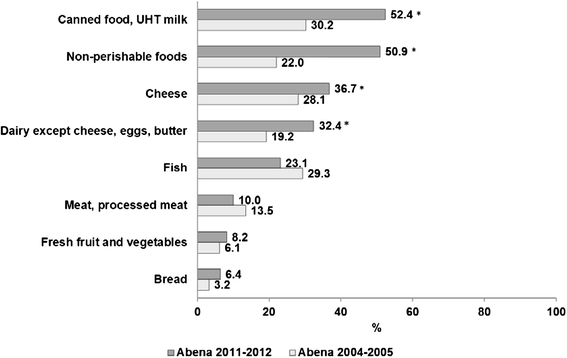
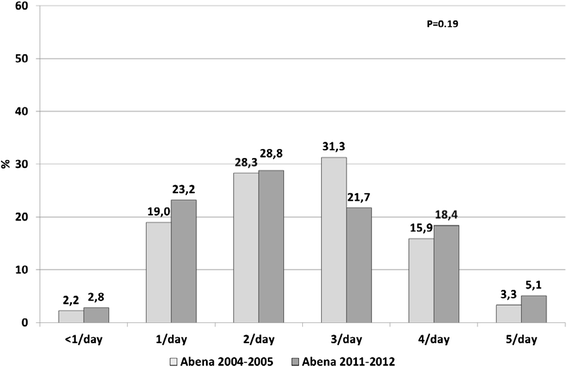
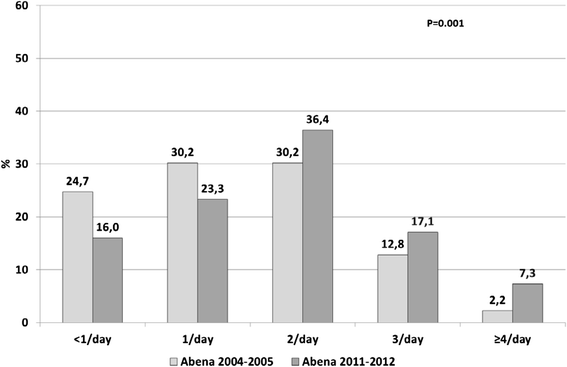
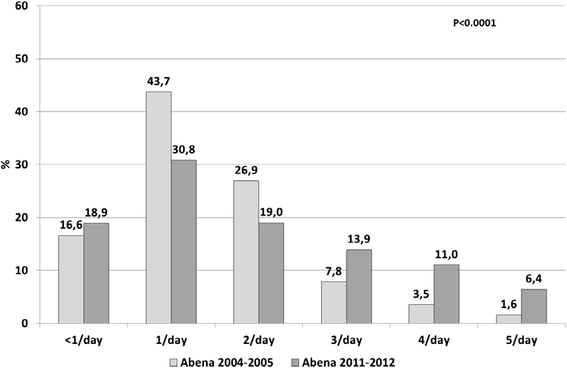
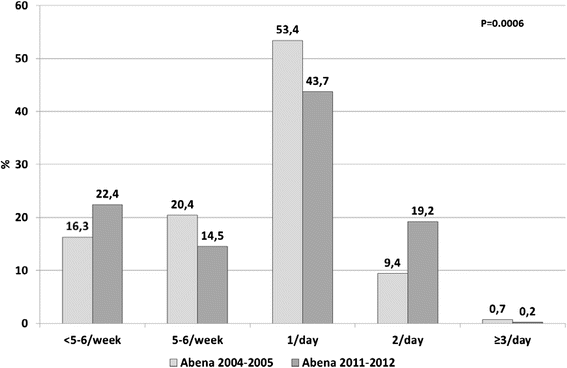
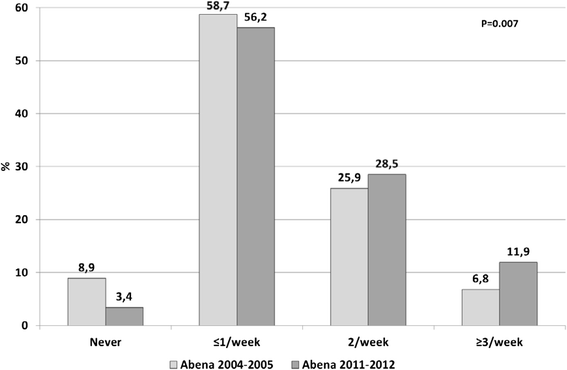
Similar articles
-
Associations of socioeconomic factors with inadequate dietary intake in food aid users in France (The ABENA study 2004-2005).Eur J Clin Nutr. 2010 Apr;64(4):374-82. doi: 10.1038/ejcn.2009.153. Epub 2010 Jan 20. Eur J Clin Nutr. 2010. PMID: 20087381
-
Dietary behaviour and nutritional status in underprivileged people using food aid (ABENA study, 2004-2005).J Hum Nutr Diet. 2011 Dec;24(6):560-71. doi: 10.1111/j.1365-277X.2011.01158.x. Epub 2011 May 13. J Hum Nutr Diet. 2011. PMID: 21564343
-
Dietary Behaviors among Public Health Center Clients with Electronic Benefit Transfer Access at Farmers' Markets.J Acad Nutr Diet. 2017 Jan;117(1):58-68. doi: 10.1016/j.jand.2016.07.012. Epub 2016 Sep 9. J Acad Nutr Diet. 2017. PMID: 27618576
-
[Simple obesity in children. A study on the role of nutritional factors].Med Wieku Rozwoj. 2006 Jan-Mar;10(1):3-191. Med Wieku Rozwoj. 2006. PMID: 16733288 Review. Polish.
-
Food insecurity, food assistance and weight status in US youth: new evidence from NHANES 2007-08.Pediatr Obes. 2014 Apr;9(2):155-66. doi: 10.1111/j.2047-6310.2012.00143.x. Epub 2013 Jan 31. Pediatr Obes. 2014. PMID: 23364918 Review.
Cited by
-
Who uses foodbanks and why? Exploring the impact of financial strain and adverse life events on food insecurity.J Public Health (Oxf). 2018 Dec 1;40(4):676-683. doi: 10.1093/pubmed/fdx133. J Public Health (Oxf). 2018. PMID: 29145590 Free PMC article.
-
The lived experience of food pantry users in Minnesota: Qualitative findings from a statewide survey.J Hunger Environ Nutr. 2023;18(2):178-191. doi: 10.1080/19320248.2021.1932663. Epub 2021 Jun 7. J Hunger Environ Nutr. 2023. PMID: 36950310 Free PMC article.
-
Investigation of the quality of life of patients with hypertension in health centers.J Educ Health Promot. 2020 Jul 28;9:185. doi: 10.4103/jehp.jehp_741_19. eCollection 2020. J Educ Health Promot. 2020. PMID: 32953912 Free PMC article.
-
Prevalence of food insecurity among food bank users in Germany and its association with population characteristics.Prev Med Rep. 2018 Jan 28;9:96-101. doi: 10.1016/j.pmedr.2018.01.005. eCollection 2018 Mar. Prev Med Rep. 2018. PMID: 29527460 Free PMC article.
References
-
- Food and Agricultural Organization. Rome Declaration on World Food Security. 1996. http://www.fao.org/docrep/003/W3613E/W3613E00.HTM. [Accessed 13 July 2016].
-
- Coleman-Jensen A, Gregory C, Singh A: Household Food Security in the United States in 2013. US Department of Agriculture; 2014. http://www.ers.usda.gov/media/1565415/err173.pdf. [Accessed 13 July 2016].
MeSH terms
LinkOut - more resources
Full Text Sources
Other Literature Sources

